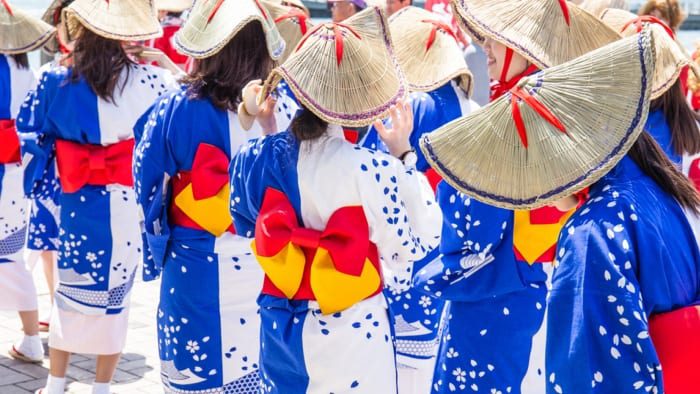 The obi is undeniably one of the most intricate and eye-catching elements of traditional Japanese fashion. It started as a simple sash, just a few inches wide, serving the sole purpose of tying clothes in place. However, during the Edo period, much like the kimono, the obi evolved into a fashion statement. It transformed from a plain strip of cloth to a foot-wide band of fabric, requiring cords to secure it in place. The knots that once were simple in the front became complex and shifted to the back, allowing for elaborate displays and enhanced comfort. The obi’s width also provided the means to conceal the ohashori, the fold created by tucking the kimono up into the belt to raise the hem. Moreover, tying the obi in the front made it easier to adjust if needed.
The obi is undeniably one of the most intricate and eye-catching elements of traditional Japanese fashion. It started as a simple sash, just a few inches wide, serving the sole purpose of tying clothes in place. However, during the Edo period, much like the kimono, the obi evolved into a fashion statement. It transformed from a plain strip of cloth to a foot-wide band of fabric, requiring cords to secure it in place. The knots that once were simple in the front became complex and shifted to the back, allowing for elaborate displays and enhanced comfort. The obi’s width also provided the means to conceal the ohashori, the fold created by tucking the kimono up into the belt to raise the hem. Moreover, tying the obi in the front made it easier to adjust if needed.
In women’s attire, the obi stands out prominently and never matches the kimono’s fabric, as it serves not just as a belt but also as a fashion accessory, akin to a necklace or a hairpiece. Women choose obis that complement the kimono’s colors while making a statement of their own. These wide belts are long enough to wrap generously around the waist.
Obi belt knots are an art in themselves, with some of the most elaborate shapes requiring the use of pillows to shape them. While the knowledge of such knots has faded since the 18th and 19th centuries, some historians and “kimono-wearing schools” still preserve the techniques to recreate the antique shapes. In modern times, most people opt for a simple drum knot to tie their obi. Tsuke obis, on the other hand, utilize a short cord to tie the belt behind the back and create the illusion of a knot with a wire hook.
Compared to women’s obis, men’s obis are simpler, only four inches wide, and tied in a straightforward knot at the back of the waist. They serve a more functional purpose and come in two types: the heko obi, soft and informal, worn by boys and young men, and the kaku obi, a simple silk belt with a flat knot called “kai no kuchi,” worn by older men.
Children’s obis resemble smaller versions of adult obis, except for the very young, who may wear gentler cloth instead, resembling a soft cotton scarf, tied in a simple square knot. Tsuke obis are also common in children’s outfits for their ease of tying and removal.
At Japanese Style, we offer a selection of men’s, women’s, and children’s obis. If you have any questions, please feel free to email us!



